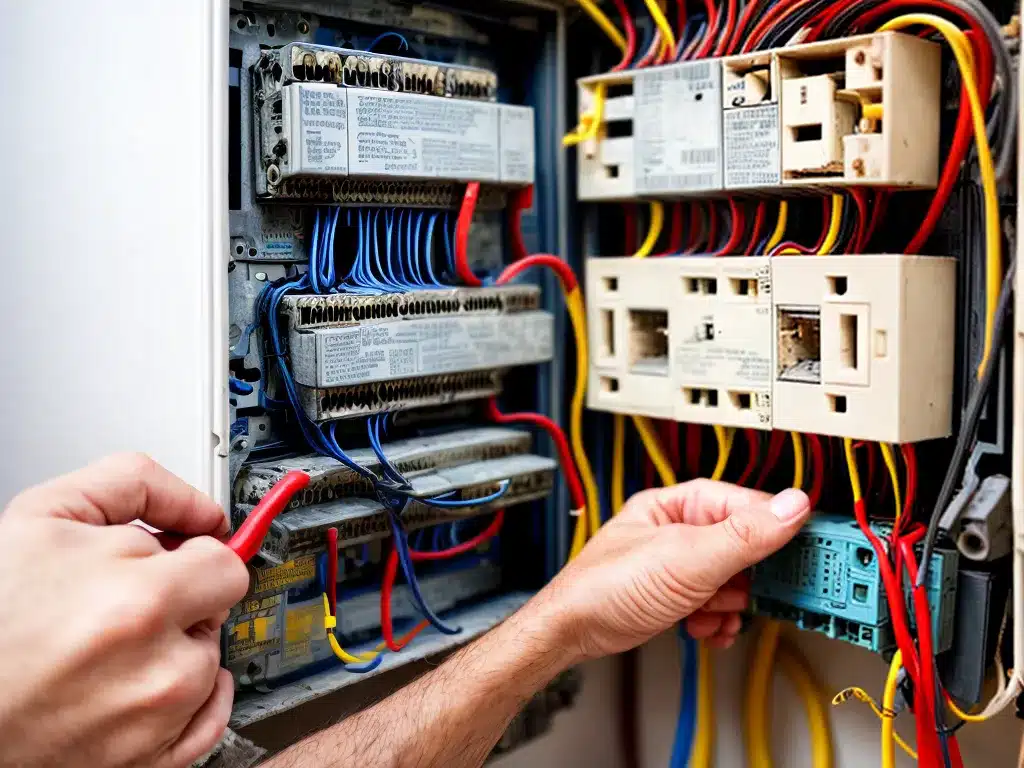 Outdated Electrical Systems” />
Outdated Electrical Systems” />
Outdated electrical systems in homes can pose serious safety hazards. Thankfully, there are steps you can take to identify problems and reduce risks. This guide will explore the dangers of outdated electrical and provide actionable tips to protect yourself and your family.
What Are the Risks of Outdated Electrical Systems?
Old electrical systems that have not been updated to meet modern safety codes can present various hazards, such as:
Fire Risk
-
Old wiring can fray, corrode and loosen over time, increasing the chance of short circuits and electrical fires. This risk increases if wires are overloaded with too many appliances.
-
Outdated breaker boxes and faulty circuit breakers that fail to trip can also lead to dangerous arc faults and overheating.
Shock and Electrocution
-
Un grounded or improperly grounded outlets and wiring increase the risk of shocks. Improper grounding means electricity can flow through your body to reach the ground.
-
Exposure to live wires from damaged insulation or connections can lead to electrocution. This risk increases with water sources like kitchens and bathrooms.
Equipment Failure
-
Connecting modern sensitive electronics and appliances to outdated electrical can lead to blown fuses, power surges, and equipment damage or failure.
-
Overloaded and insufficient wiring prevents proper voltage and can burn out motors in items like the refrigerator.
How to Identify Problems with Electrical Systems
Here are some steps to identify issues with outdated and dangerous electrical:
Check the Age
-
The age of your home can give insight into potential issues. Homes older than 40 years often have outdated electrical systems.
-
Some signs of age are two prong ungrounded outlets, cloth wrapped wiring, and fuse boxes.
Listen for Crackling Sounds
- Crackling, buzzing or sizzling from outlets can indicate loose wiring and connections. This may precede a short circuit.
Notice Flickering Lights
- Lights that flicker, especially when appliances turn on, often mean the system is overloaded and wires can’t handle the voltage.
Feel for Warm Outlets
- Hot outlets indicate potential loose connections in the wiring leading to overheating. This creates a fire hazard.
Look for Burn Marks
- Burn or scorch marks around outlets signal dangerous short circuits or arcs have occurred. Have an electrician inspect immediately.
Test with Circuit Testers
- Inexpensive circuit testers will detect incorrectly wired outlets or other problems. GFCI outlet testers check grounding.
Hire an Inspector
- A qualified electrician can thoroughly inspect for issues like grounding, overloads, and code violations that need correction.
How to Protect Yourself from Dangers
Here are key tips to protect yourself from outdated electrical:
Update the Electrical Panel
- A modern electrical panel with enough capacity and circuit breakers prevents overloads. Breakers immediately stop dangerous arcs or shorts.
Rewire with Modern Copper
- Replacing outdated wiring with new copper wiring will prevent fires from deterioration and increase capacity.
Add GFCI Outlets
- GFCI outlets shut off power instantly if electricity flows outside the outlet’s circuit to prevent shocks. Install near water sources.
Consider AFCI Breakers
- AFCI breakers detect dangerous arcs in wiring and stop them before fires start. Upgrade your panel.
Address Grounding Issues
- Properly ground outlets and wiring by connecting them to earth to prevent shocks. Hire an electrician if unsure.
Inspect Extension Cords
- Don’t overload extension cords and inspect them for damage. Consider additional outlets or rewiring to reduce cord usage.
Install Smoke Alarms
- Have working smoke alarms on every level of your home to alert you of electrical fires as early as possible.
Create an Electrical Plan
- Have an electrician provide an electrical assessment of your home’s systems and a plan for needed fixes and upgrades. Prioritize critical safety issues.
Outdated electrical is the source of around 50,000 home fires per year. Protect yourself and your family by taking proactive steps to identify risks and address problems. If in doubt, hire a qualified electrician to inspect your electrical systems and provide guidance. Investing in necessary upgrades will provide long-lasting safety.
